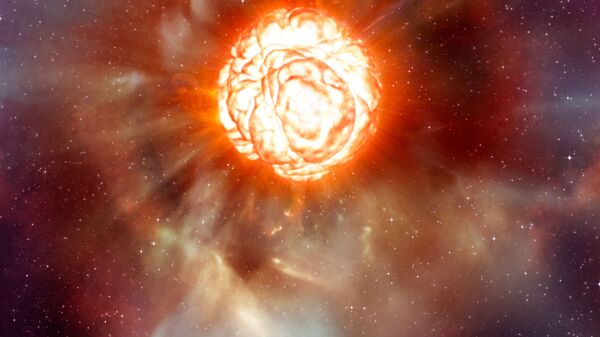The bright, red star Betelgeuse that made headlines late last year when it manifested a sudden dramatic dimming in late 2019 isn't about to explode, as some scientists had rushed to speculate, but may be simply “dusty”, a new study shows.
In a paper accepted to Astrophysical Journal Letters and published on the preprint site arXiv, astronomers at the University of Washington and the Lowell Observatory have expanded on their observations of Betelgeuse dated 14 February at the Flagstaff, Arizona, observatory.
The new studies feed into the more benign theory that Betelgeuse is not about to go supernova and explode in a dramatic dying spectacle, but rather shed some material from its outer layers.
The later process is something that is often witnessed in the case of red supergiant stars.
“We see this all the time in red supergiants, and it’s a normal part of their life cycle. Red supergiants will occasionally shed material from their surfaces, which will condense around the star as dust. As it cools and dissipates, the dust grains will absorb some of the light heading toward us and block our view,” said Emily Levesque, University of Washington associate professor of astronomy and co-author of the study.
Together with Philip Massey, an astronomer with Lowell Observatory, Levesque had used the 4.3-metre Lowell Discovery Telescope and a spectrometer equipped with a filter to lower light intensity to carry out observations in February to measure the average surface temperature across Betelgeuse. This was achieved by analysing the spectra of light reaching Earth.
The researchers determined the star’s average temperature on 14 February was about 3,325 Celsius (6,017 Fahrenheit) - 50 to 100 degrees cooler than measurements made in 2004.
These findings did not sit well with the earlier suggested theory that Betelgeuse’s dimming has been caused by “huge convection cells rising to the surface and cooling”.
If that was the case, a much greater decrease in temperature between 2004 and 2020 would have been registered.
“A comparison with our 2004 spectrum showed immediately that the temperature hadn’t changed significantly… We knew the answer had to be dust,” said Massey.
Betelgeuse most likely “sneezed out” a huge cloud of dust, which obscured its light for a while, causing the dimming effect.
While the original theory that Betelgeuse will explode as a supernova within the next 100,000 years when its core collapses still holds true, the star’s dimming, first noticed last October, is thus not necessarily a sign of its looming demise, according to the research.
The Dimming of Betelgeuse
Late last year, news broke that red giant Betelgeuse, which is well-advanced in age, was fading significantly, enough to be noticeable with the naked eye, losing some 40 per cent of its usual brightness. It was these observations that fueled speculations of an imminent massive supernova explosion.
Updated #Betelgeuse forecast pic.twitter.com/7HAoB4Vk6y
— Betelgeuse Status (@betelbot) March 9, 2020
Betelgeuse, about 700 light-years away, in the constellation of Orion, is one of the brightest stars in the sky and estimated to be around 8 to 8.5 million years old.
In the final stages of its lifespan, Betelgeuse is assumed to have run out of hydrogen a while back, and is now fusing helium into carbon and oxygen.
As its core fuses ever heavier elements, ultimately a buildup of iron will result in the core collapsing as the orb explodes in a supernova.
The dimming is understood by scientists to be a sign that the star is about to die.
212 Hour Exposure of Orion the Hunter : Betelgeuse orange, Rigel bright blue lower right (apod.nasa.Archive) 🚀🔭⭐️ pic.twitter.com/cRgjf8jQhT
— HERVE (@HERVE73950491) March 9, 2020
Now astronomers are leaning towards the theory that Betelgeuse still has a few tens of thousands of years before that cataclysmic event happens.


